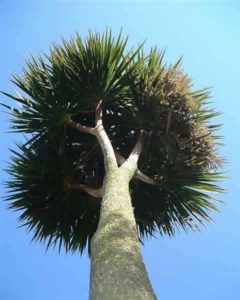Not really a palm at all, but still at the core of many exotic gardens.
There are two main species of Cordyline available in the UK, Cordyline australis, and named varieties, sold by the million, and Cordyline indivisa, much rarer, with wider leaves, and much more difficult to grow.. Australis has very many varieties, from the plain green form, through coloured, to striped, bi-coloured, and now tri-coloured. One problem is that many sellers in the US call any Cordyline with a single trunk indivisa, and this leads to confusion
The two types naturally occur in different locations with australis in lowland areas, and indivisa in the cooler mountains.
Cordyline australis can be grown in any garden soil but appreciates some compost added. Grow in sun or shade, and while can be drought tolerant, prefers adequate water in warm weather. Hardy as a trunked tree to -9C, although will survive being killed to ground level at lower temperatures. It will then regrow multi-trunked from the rootstock the next year.
Cultivation differences between C australis and C indivisa. Whilst C. indivisa will tolerate cooler overall temperatures, it is less likely to regenerate from the rootstock if badly hit by hard frosts. It requires evenly moist, but well drained, deep, humus rich soil, and plenty of humidity. For C.indivisa the ideal temperatures appears to be in the -5C to 25C range. Either side of these and the plant struggles. Can take sun or shade, but a shady position may be preferable where temps are likely to be higher than 25C






